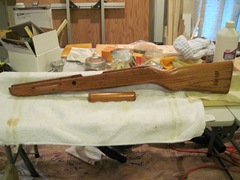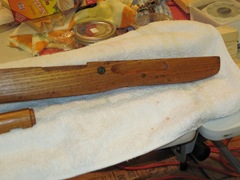When last we left the intrepid SKS stock refinisher he was at the point where the stock had now gotten its proper oil finish. There was far more even tonal qualities than at the start with the first Tung oil go-around and the actual deep tonal differences side to side, front to back and top to bottom had finally started to even out. Only the grip area remained as a darker area and that is more from past use than actual wood tone differences. As a polymerized oil is good against some chemicals but not so hot against water, it was time to put on finish that would start to address that problem. This meant some older chemistry in the form of shellac with sandarac resin and a dollop of Venetian Turpentine to help give some flexibility to the shellac layer and cut its gloss just a bit. As seen previously such a mixture applied to fresh wood without any oil on it gives a matte coating (and one of the best I've seen so far for these things).
I had thought that adding a bit of lamp black (soot or 'inletter's black') would help, but a test board proved out that you get a weak black coating that isn't opaque and that you really can't do much with. Here the original matte is on the right and the blackened is on the left with one, single brush on coating.
Unless this is your aim, don't do this. If you are going for that 'wood that has been out in the sun for ages' look, then this is your solution. A couple of coats of this and anything later should look like driftwood... you know that is very tempting as an alternative if you wanted someone to think you had a decrepit piece of wood and then demonstrate that it was as sounds as fresh wood...
But I digress, yet again.
Now on to the actual varnish put on the stock.
Right side:
An attempt to get something without a flash artifact...
Note reflected light from varnish.
And on to the left side:
To me this is a pretty glossy varnish, although not as glossy as the original shellac. When applied over oil worked wood it is in no way matte in character. With that said it is very hard to say that the appearance is that of one applied 'over' wood in that it doesn't have any great amount of depth to it as, say, a Browning Auto-5 clear coat has. Yet it is not what most military users ever want in a color scheme as it is both too light and too glossy for what people consider for a gun stock.
This is, however, meeting a number of original criteria in showing up the actual beauty of the wood and retaining much of the original wood markings (including imperfections that were done at the arsenal or at the original manufacturing site). It is also done utilizing what would be available in the 1950's in Yugoslavia (although searching around a bit for some of the items might make it a bit harder to do). Here is how what has been done stack up against the original criteria at this point:
1) This will sand down (with 400 grit or higher sandpaper at this point) and steel wool replacement or bronze wool will also knock it down. Still high on the upside for finishing here.
2) Dries in one day - All applications do that to-date.
3) Must be able to take high temps near the barrel. This is not a Mosin-Nagant (which, it has been quipped, should have had a finned barrel with a handguard under it) but an SKS in which most of the real high temp work isn't next to the wood. All the inlet areas have an oil only finish, save where there is no actual receiver contact (the screw hole areas in the bottom and the front and rear of the stock for sealing purposes).
4) After steel wool replacement or bronze wool, I can add another finish over the spirit finish.
5) Visually appealing. To me this is getting to be pretty nice for a total amateur's first time around with a gunstock. I have, luckily, fooled around with other wood and am keeping to the KISS principle here. Remember to 'Keep It Simple, Stupid'.
6) Nothing fancy. This is not only not fancy to this point, but something that could have been done in the 19th century.
7) Need not match arsenal look. It doesn't. Anything over what I got is an improvement.
8) Easily available materials in Yugoslavia circa 1950's or early 1960's. In theory, yes, all of this to this point is available at that place at that time or with local substitutes.
9) Low maintenance. Unknown but the spirit varnish layer promises much of that if it has a final layer over it.
10) Hunting scent friendly. So far, so good, but would need nothing more than what is normally done on a hunt to hide its scent.
Things that can be done to give a final finish to the stock to get to the putting the hardware back in:
- An oil varnish like a spar varnish. Mix varnish with 1/3 Tung/BLO/Walnut oil and 1/3 Turpentine. I'm looking for a nice matte varnish for this. If going with a varnish that has polyurethane then #8 and possibly #6 are crossed off the list, which kills some variations like Waterlox if I read their ingredients correctly. Something like one of the Tried And True finishes would keep things in the ballpark if you could get someone like an instrument maker to supply an oil varnish in Yugoslavia (which they did have at the time, just tough to get in the field). If I could make my own without involving boiling oil but gently heating an oil, then I would consider doing that. More research on the last is necessary.
- Oil coat. Apply thin (1:1 with Citrus Solvent) for a quick coat and forget the glossy appearance. Or apply straight which is quick, easy, adds some alcohol resistance to the varnish and use 400 grit sandpaper to knock down the gloss, as well. Quick, easy, fun to do!
- Wax coat. A nice, sturdy wax that goes on thin would do the job of adding a different solvent resistance to the stock. This I can actually formulate my own with, yes, ingredients found in Yugoslavia at the period (if you can get waxed shellac and beeswax, then you can easily do this).
- Leave as-is, and do NOT use alcohol based gun cleaners (that means taking car with the old Backwoods formula of 1/3 Rubbing Alcohol, 1/3 Hydrogen Peroxide and 1/3 Murphy's Oil Soap mixture). Actually this is an option if temperature resistance will hold up at the exhaust port holes.
This is a different concern from the Mosin-Nagant that has a free floating barrel through the handguard area where the SKS has exhaust port holes for the piston that chambers the next round. With the Mosin there is hot air build up in the space between the barrel and handguard with the wood serving as a buffer for the finish. In the SKS the hot air is immediately exhausted out (in part) through the vents in the handguard with some intermix in the space between the handguard and the receiver. That really needs something that can take that immediate hot air mix which mixes with warm air in the piston then cooler air next to the receiver during the forward stroke (pulling air in) and then on the backstroke (exhausting the air). In theory that should be below the 140-180 degrees F. damage temps for shellac or shellac/resin. In theory. This is the old 'Theory and Practice Conundrum' rearing its head yet again. With that said, the arsenal only expected naturally polymerized BLO to do the job, so shellac should be relatively safe.
Actually a clear-coat enamel was available in Yugoslavia at the time (actually that dates back to the late 19th century via alkyd paints if I'm reading my history right), so picking up a matte clear bottle of Testor's would do the job... and enamel hardens with heat... hmmmm... decisions, decisions...

























































 Supporting Friends and Allies
Supporting Friends and Allies





